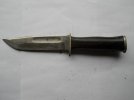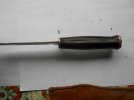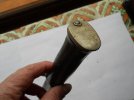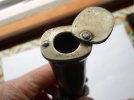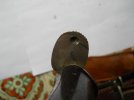OK - THIS ONE is a puzzler. Another pair of questions -
What does the handle look like from a top down or bottom up view? I mean, can you see the tangs or are they hidden from sight? With true Western double tang construction, you can see the tangs on the top and bottom. The leather disks then look like "H"s.
What does the pommel end of the handle look like? Can you see a metal bar running from tang protrusion to tang protrusion, or do you see leather/plastic in between the two tang points.
The answers to these questions (and pics if possible

)will help me decide in my mind if it was really made by Western,
According to all the information I have or have seen, Western never made a finger groove knife.
To my knowledge, other than the rare Kabar that gunsil posted above, no one else ever made a double tang knife, unless someone did a few "one-offs".
By the way, gunsil, the pommel on your knife looks very much like the flat pommel Western used on the L36K, made briefly starting in 1936, and so relatively rare that very few of them turn up.
The non-Western marked knives were made under contract for re-sellers, such as Sears, Western Auto, Montgomery Wards and Coast Cutlery.
First, my guess, and that is all it is, well, actually it's 2 really big WAGs...
The first and most likely, with the caveat that this only if it really is a Western made knife, is that it is some kind of post-WW2 employee made one off knife constructed using left over parts from WW2.
- it has an L71 blade shape ==> left over blade
- the leather disks and spacers seem to all be present ==> from the ends - 2 black spacers preceding and trailing white/red/white spacers
- and the colored spacers and brass guard would indicate post-WW2 (no brass guards on Western knives from 1942 to 1946).
- the tangs exposed by the missing pommel indicate that it had a bird head pommel, using the assumption that the spacers all SEEM to be present.
- if you fill in the finger grooves mentally, the handle shape becomes that used on the L71s (slight bulge in the middle of the handle).
The second possibility is that it is a post-war factory refurb with the subsequent addition of finger grooves. Again, with the guess only valid if it is a Western knife.
In 1961, Western wrote a letter to Mr. M. H. Cole, responding to a query about an unusual aluminum handled Western Bx54 Bushman. Mr. Cole included the letter in his books. A statement in the letter mentioned that at that time (1961) Western was routinely receiving and refurbishing WW2 knives sent to them by servicemen. I sometimes wonder if the extremely rare Sharks and Baby Sharks sporting cocobolo handles are such refurbs. The only WW2 knives I've seen "advertising" cocobolo were the rare W31 USMC Parachutist knives. Every thing else was advertised as having leather handles. Well, correction - the Bx54 had black plastic handles.
IF (and its a big if) a mucked up L71 came in for refurbishment, the clean up could possibly have buffed out a shallow Western stamp. Many of the 1950s and early 1960 Westerns had 3 to 5 spacers, in red/white or red/white/brass configurations. The refurbisher could have just included the current spacer pattern. Maybe the factory added finger grooves at the customers request or the customer could have had them added later, although the grooves appear to be to even to be a home-grown.
Now for the facts, suppositions and WAGs that lead me to this above WAGs. And the WAGs also assume that this is a Western produced knife. There does exist the possibility that
The blade shape and size APPEARS to match that of the WW2 version of the L71, sometimes called a G46-5, although Western never called them that. Their name for the 5" WW2 L71, w/ an unfullered blade was the Seabee, primarily because Navy Construction Battalion (SeaBees) units kept ordering large quantities to them.
From 1931 to 1941, Western made the G46 with 3 blade lengths - 4-1/4", 5" and 6". These blades were fullered. The pommels were what I call "mushroom shaped".
During WW2, Western made 3 flat pommel (such as those found on WW2 1219C2/USN-MK2 knives) ::
- the G46-8 with an 8" blade
- the 5" bladed L71
and
- a 6" bladed version that had the same blade characteristics as the WW2 G46-6 (called the "SHARK" - see more below).
So now let's confuse the issues with some more facts.

Western was the first to use (as far as I can determine) and subsequently popularized, the aluminum bird's head rounded pommels starting in the 1931.
During WW2, Western made aluminum bird head pommel 5" and 6" blades on the G46 pattern. Some were fullered, some were not. Western named the 6" knives "The Shark", actually advertising it with that name during WW2 in wartime promotion ads that promised to get them to civilian market as soon as possible/allowed. The 5" knife picked up the name "Baby Shark". The 6" knife pommel had a lanyard hole. The 5" knife did not. The Sharks and Baby Sharks latter were produced with plastic pommels and steel or plastic guards.
Now let's throw another monkey in the works - the sheath - to my knowledge, Western NEVER made a sheath with a sharpening stone pocket until Coleman did it with the black or green Cordura sheaths of the Model 221 in the late 80s.
The blade looks like A Western model, but the handle doesn't and the sheath doesn't. But the sheath could have been a generic replacement at any time.
My Qs about the tang? Trying to make me lean one way or the other. It's possible also that someone made a bifurcated tang tail for holding the pommel on by pinching the tang tips in, sliding a pommel on and then letting the tips spring "out" for a friction fit.
So more pics please.




